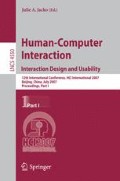Abstract
We analyze and discuss human performance model for PBUI (Push-Based User Interface) in this paper. PBUI is a user interface method in which a user performs a desired task by selecting a target object that usually represents the task itself. The candidate objects are sequentially and automatically presented to the user by the system. When a target object is presented, user selects the target object by a simple action such as just pushing a button. In this paper, we propose human performance model of PBUI and discuss the characteristics of PBUI. We also evaluate performance of PBUI by comparing with GUI.
Access this chapter
Tax calculation will be finalised at checkout
Purchases are for personal use only
Preview
Unable to display preview. Download preview PDF.
References
Margone, S., Shneiderman, B.: A study of file manipulation by novices using commands versus direct manipulation. In: Twenty-sixth Annual Technical Symposium, pp. 154–159. ACM, Washington DC (1987)
Maulsby, D.L., Witten, I.H.: Inducing programs in a direct manipulation environment. In: Proc. CHI’89 Conference, Human Factors in Computing Systems, pp. 57–62. ACM, New York (1989)
Card, S.K., Moran, T.P., Newell, A.: The Psychology of Human-Computer Interaction. Lawrence Erlbaum Associates, Mahwah (1983)
Takekuni, T., Urano, N., Morimoto, K., Kurokawa, T.: Proposal of Push-based User Interface and its Operating Characteristics. In: 2003 Japan Ergonomics Society Kansai branch conference proceedings, pp.146– 149 (2003)
Takekuni, T., Urano, N., Morimoto, K., Kurokawa, T.: A Study on Number of Objects in Push-Based User Interface. In: Human interface symposium proceedings, pp.109–112 (2004)
Li, Q., Urano, N., Morimoto, K., Kurokawa, T.: A study of the visual Push-Based User Interface that considers practicality. In: The 7th. human media workshop proceedings (2006)
Author information
Authors and Affiliations
Editor information
Rights and permissions
Copyright information
© 2007 Springer-Verlag Berlin Heidelberg
About this paper
Cite this paper
Urano, N., Morimoto, K. (2007). Human Performance Model and Evaluation of PBUI. In: Jacko, J.A. (eds) Human-Computer Interaction. Interaction Design and Usability. HCI 2007. Lecture Notes in Computer Science, vol 4550. Springer, Berlin, Heidelberg. https://doi.org/10.1007/978-3-540-73105-4_72
Download citation
DOI: https://doi.org/10.1007/978-3-540-73105-4_72
Publisher Name: Springer, Berlin, Heidelberg
Print ISBN: 978-3-540-73104-7
Online ISBN: 978-3-540-73105-4
eBook Packages: Computer ScienceComputer Science (R0)

